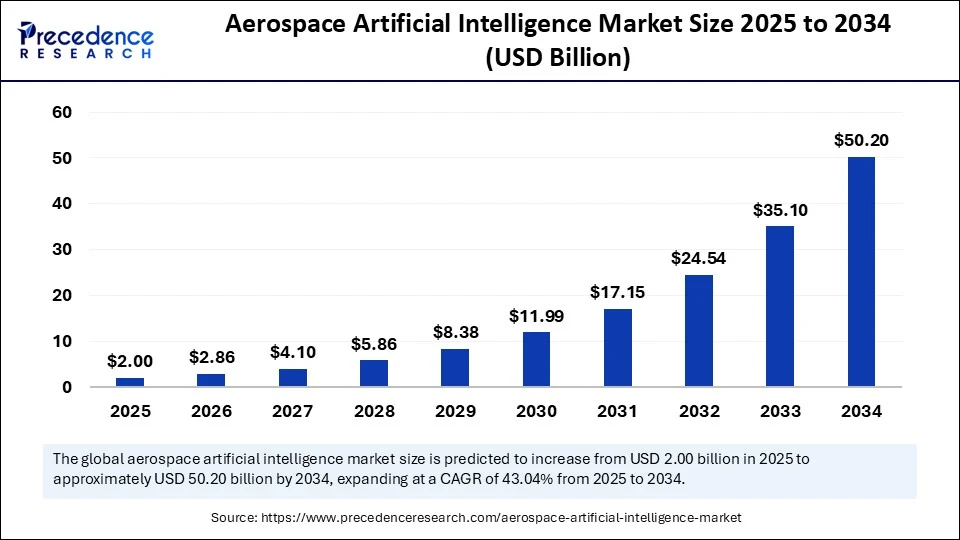According to Precedence Research, the global aerospace artificial intelligence (AI) market, valued at approximately USD 1.40 billion in 2024, is anticipated to surge to nearly USD 50.20 billion by 2034. This represents an exceptional CAGR of 43.04% from 2025 to 2034. Key growth catalysts include the rapid integration of machine learning into flight systems, the rising need for predictive analytics, and the increasing adoption of AI-driven surveillance and autonomous capabilities.

Aerospace Artificial Intelligence Market Key Highlights
-
Market size: USD 1.40 billion in 2024 → USD 50.20 billion by 2034
-
Regional leader (2024): North America with 42.6% market share
-
Fastest-growing region: Asia Pacific through 2034
-
Top offering (2024): Software with 38.5% share; services forecast to grow fastest
-
Leading technology (2024): Machine learning (deep learning) with 41.2% share; computer vision expected to lead growth
AI’s Transformational Role in Aerospace
Artificial intelligence is emerging as a critical “co-pilot” in modern aerospace. As aircraft systems become increasingly complex and data-intensive, AI enables real-time data analysis, predictive decision-making, and advanced mission planning.
Machine learning algorithms now power autonomous drones, optimize air traffic, and boost fuel efficiency through intelligent routing. AI is also redefining predictive maintenance by analyzing sensor data to forecast potential equipment failures — reducing downtime, improving safety, and allowing precise aircraft health management.
Aerospace Artificial Intelligence Market Key Growth Drivers
-
Autonomous aerial platforms – Rapid advancements in drones and UAVs rely on AI for navigation, obstacle avoidance, and mission execution. Defense agencies worldwide are investing in AI-driven surveillance and tactical systems.
-
Predictive maintenance adoption – AI tools help airlines and manufacturers anticipate component wear, reducing costs and preventing delays.
-
Real-time analytics demand – Increasing need for mission-critical decision-making in avionics, onboard diagnostics, and software systems.
-
Supportive regulations & collaboration – Governments and aviation bodies are funding AI research, updating policies, and encouraging public-private partnerships.
Aerospace Artificial Intelligence Market Scope
| Report Coverage | Details |
|---|---|
| Market Size (2034) | USD 50.20 Billion |
| Market Size (2025) | USD 2.00 Billion |
| Market Size (2024) | USD 1.40 Billion |
| CAGR (2025–2034) | 43.04% |
| Leading Region | North America |
| Fastest Growing Region | Asia Pacific |
| Base Year | 2024 |
| Forecast Period | 2025–2034 |
| Segments Covered | Offering, Technology, Application, Platform, Deployment, End User, Region |
| Regions Covered | North America, Europe, Asia-Pacific, Latin America, Middle East & Africa |
Aerospace Artificial Intelligence Market Emerging Opportunities & Trends
-
Computer vision applications – Enabling automated object detection, aircraft surface inspections, and advanced satellite imaging.
-
Digital twin technology – Virtual replicas of aircraft and components for optimizing design, performance, and maintenance.
-
Edge AI – Onboard processing for faster, real-time responses in mission-critical operations.
-
Asia Pacific growth potential – Expanding aviation fleets, AI talent development, and investments in next-generation air mobility solutions are positioning the region as a key growth hub.
Also Read: Semiconductor Laser Market
Segmentation Overview
By Offering
-
Software: Led the market in 2024 with 38.5% share, driving analytics, flight optimization, and autonomous controls.
-
Services: Expected to grow fastest, including AI consulting, integration, training, and cloud-based aerospace solutions.
By Technology
-
Machine Learning (incl. Deep Learning): Largest share in 2024 at 41.2%, supporting route planning, control automation, and complex data interpretation.
-
Computer Vision: Anticipated to grow fastest, used in inspections, satellite image processing, and security systems.
By Region
-
North America: 42.6% share in 2024, driven by strong defense budgets, advanced aerospace manufacturing, and early AI adoption.
-
Asia Pacific: Forecast to post the fastest CAGR, backed by expanding airline operations and AI-led innovation in China, India, and Japan.
Market Challenges
-
High integration costs – Retrofitting legacy aircraft with AI-ready infrastructure is expensive.
-
Cybersecurity risks – Increased connectivity raises vulnerability to hacking and system manipulation.
-
Regulatory uncertainty – Evolving rules for autonomous flight and AI decision-making create deployment delays.
Leading Companies & Innovations
-
Airbus – Skywise big-data platform with AI for performance monitoring.
-
Boeing – AI-enhanced navigation and cockpit systems.
-
IBM – Watson AI solutions for aviation analytics.
-
Intel – Edge AI processors for real-time flight operations.
-
Microsoft – Azure AI for aerospace simulation and analytics.
-
Thales Group – AI-integrated defense radar and avionics.
-
Lockheed Martin – AI in combat aircraft and UAVs.
Case Study: Boeing’s AI-Enhanced Flight Deck
Boeing has developed AI systems to assist pilots during high-stress or emergency scenarios. These solutions mimic pilot decision patterns, offering optimal action recommendations — a step toward AI acting as a trusted digital co-pilot.
Download Sample: https://www.precedenceresearch.com/sample/6493
For inquiries regarding discounts, bulk purchases, or customization requests, please contact us at sales@precedenceresearch.com